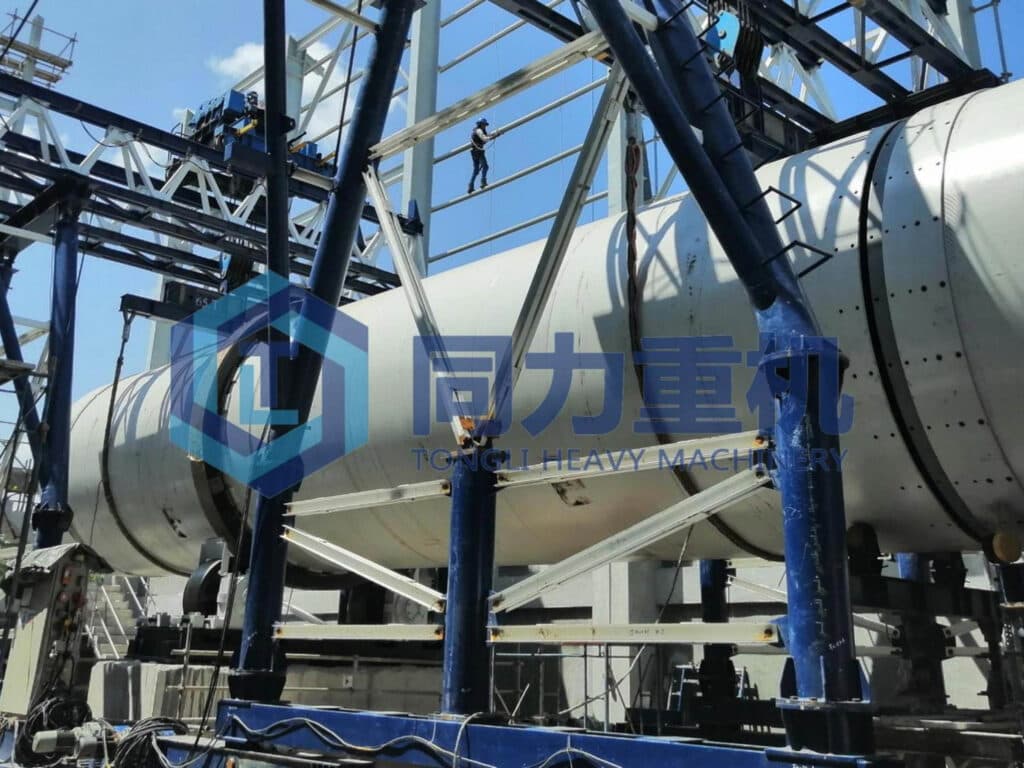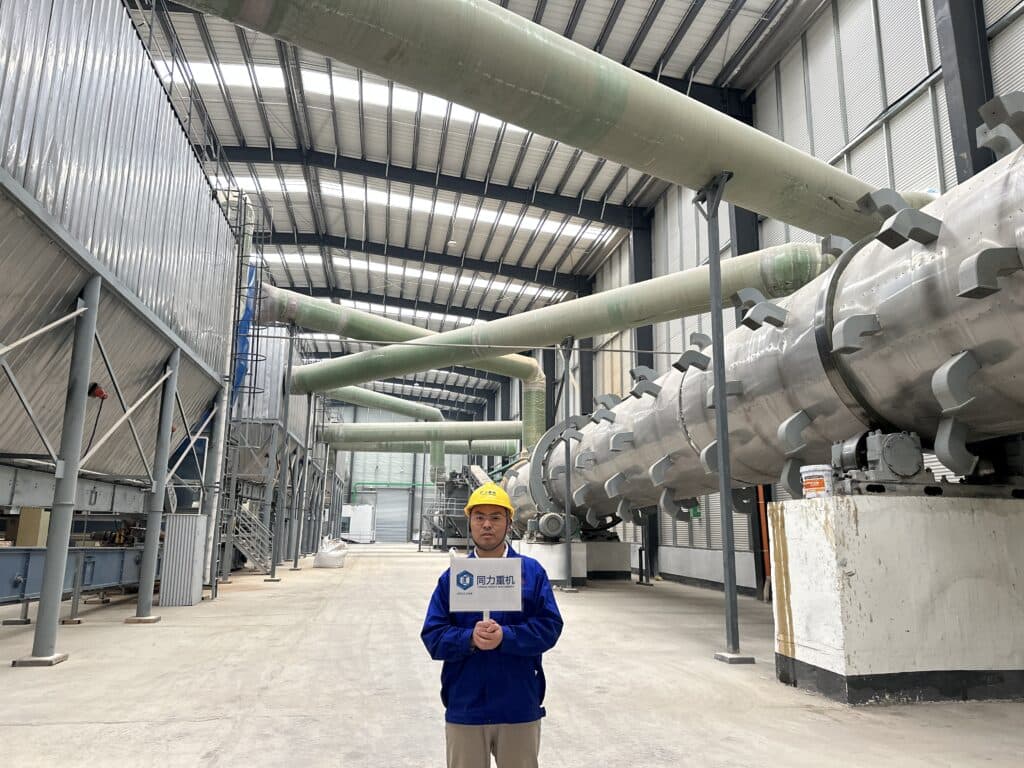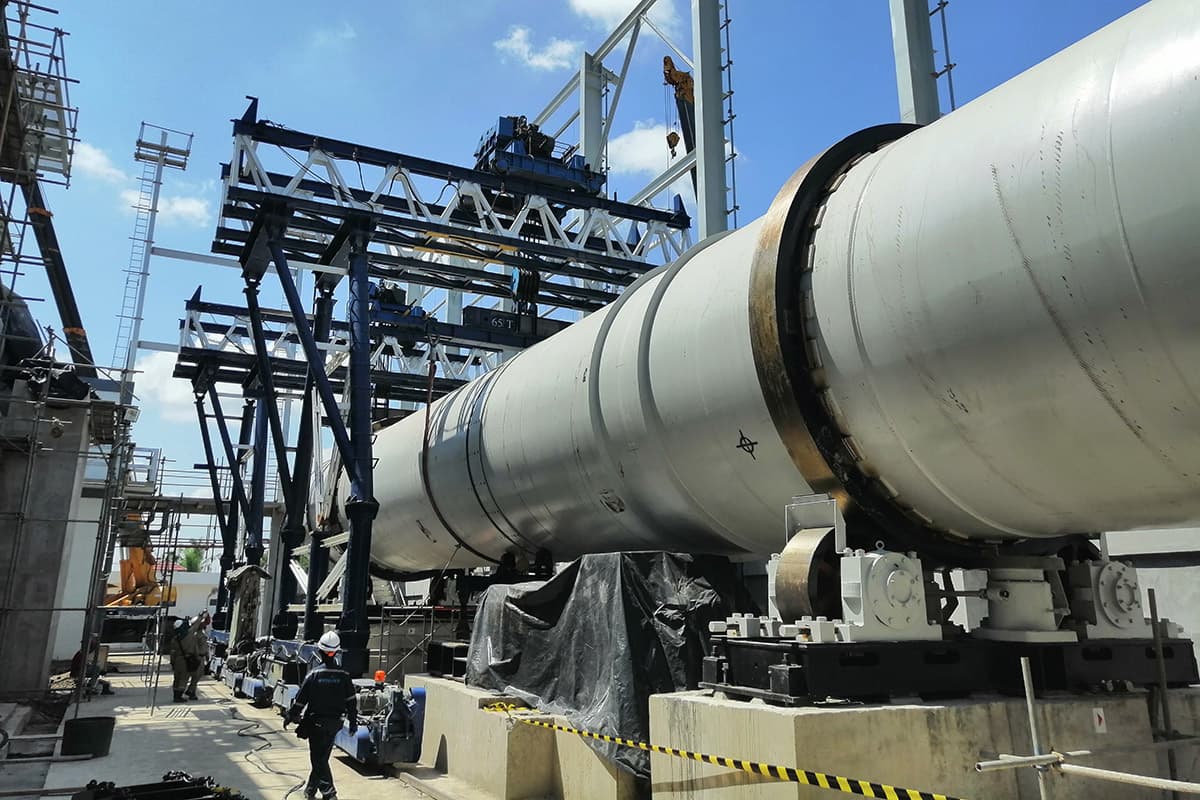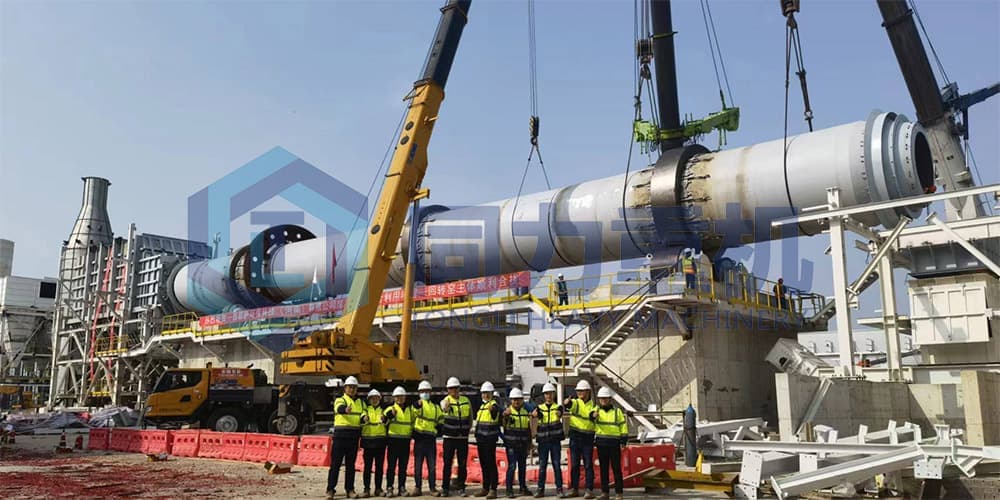Types of Rotary Drying Systems
In this article, rotary dryer manufacturer TONGLI details the types of rotary drying systems available, covering systems ranging from direct combustion to indirect heating, steam tubes to double cylinder designs. This information helps investors understand how various drying technologies work, their advantages and disadvantages, and applicable scenarios. Knowing these details can help in choosing the rotary drying system that best suits specific needs, thereby optimizing productivity and product quality.
The article’s detailed comparison not only demonstrates the unique features of each type, but also highlights their practical effectiveness in different industrial applications. Whether you need to process bulk materials or fine materials, mastering the types of rotary drying systems will help you make informed choices that enhance the economy and efficiency of your operations.

Key Points:
- Direct-fired rotary dryers: High thermal efficiency, handling bulk solids
- Indirect-fired rotary dryers: Good temperature control, suitable for sensitive materials
- Steam Tube Rotary Dryers: Efficient heat transfer, handling high-moisture materials
- Double Cylinder Rotary Dryer: Uniform drying, suitable for mild processing
- Batch Rotary Dryer: Flexible processing, suitable for small-scale operations
- Continuous Rotary Dryer: High capacity, sustained productivity
Overview of Rotary Drying Systems
Rotary drying systems are critical in a variety of industrial applications, especially for handling granular materials. These systems are designed to efficiently remove moisture from bulk materials, thereby improving product quality and reducing costs. In my experience, understanding the types of rotary drying systems is critical to selecting the right technology for specific operational needs.
At the heart of a rotary dryer is a cylindrical drum that rotates around a central axis. The material to be dried is introduced into the drum, which is heated by direct or indirect heating. As the drum rotates, the material is lifted and dropped layer by layer in hot air or a heat source, thus promoting heat transfer and moisture evaporation. The selection of a rotary drying system depends on a variety of factors, such as the characteristics of the material, the desired drying efficiency, and the operating environment.
In general, rotary drying systems can be categorized into several types, each with its own unique features and benefits:
| Type of Rotary Dryer | Heating Method | Typical Applications | Advantages |
|---|---|---|---|
| Direct-fired Rotary Dryer | Direct contact with the heat source | Minerals, ores, and bulk solids | High thermal efficiency, suitable for large capacities |
| Indirect-fired Rotary Dryer | Indirect contact with the heat source | Food products, chemicals, and sensitive materials | Reduced risk of contamination, better temperature control |
| Steam Tube Rotary Dryer | Steam heating tubes within the drum | Sludge, slurries, and pastes | Efficient heat transfer, suitable for heat-sensitive materials |
| Double Drum Rotary Dryer | Direct or indirect heating with two concentric drums | Chemical processes, granular materials | Compact design, even drying |
| Batch Rotary Dryer | Various methods depending on the design | Small to medium scale operations | Flexible operation, suitable for different batch sizes |
| Continuous Rotary Dryer | Various methods, usually direct or indirect | Large-scale production | High throughput, consistent drying performance |
Each type of rotary drying system has its own operating principles and benefits. Selecting the right system involves evaluating material properties, desired drying efficiency and overall process requirements. By understanding these key types, informed decisions can be made to optimize the drying process and increase productivity.
Direct Fired Rotary Dryers: Features and Benefits
Direct-fired rotary dryers are a widely used solution in rotary drying systems, characterized by a simple yet effective design. These dryers make direct contact with the material to be dried by introducing hot gases directly into the rotating drum. This method facilitates efficient heat transfer and promotes rapid evaporation of moisture.
The key feature of direct-fired rotary dryers is their ability to handle a wide range of materials, including those of varying moisture content and particle size. This versatility is attributed to the design of the dryer, which allows for the adjustment of process parameters within the drum, such as airflow, temperature and residence time. This adaptability makes direct-fired rotary dryers suitable for many industrial applications, from minerals and ores to agricultural products and wastes.
A significant advantage of direct-fired rotary dryers is their high thermal efficiency. Because the hot gases are in direct contact with the material, heat transfer is maximized, resulting in faster drying times. In addition, this direct contact helps to achieve a consistent and uniform drying process, reducing the possibility of hot spots or uneven drying.
In addition, direct-fired rotary dryers typically have a relatively simple and cost-effective design, which helps to reduce initial investment and maintenance costs, and their simple construction allows for easier maintenance and less downtime than some other drying systems, making them an attractive option for many industries.
Despite these advantages, the potential limitations of direct combustion rotary dryers need to be considered. For example, direct exposure of materials to hot gases may not be suitable for heat sensitive materials or materials that may react chemically with the drying medium. In addition, the quality of the exhaust gases must be carefully managed to comply with environmental regulations.
Indirectly Heated Rotary Dryers: Principle of Operation
Indirectly heated rotary dryers are an important part of a wide range of industrial drying processes, and their operating principle focuses on the efficiency of heat transfer. Unlike direct-heated dryers, which are heated by direct contact between hot gases and the material, indirect-heated rotary dryers utilize an internal heating medium to transfer heat to the material to be dried.
In an indirectly heated rotary dryer, heat is supplied through a series of external heating elements or a heated enclosure. This setup ensures that the drying medium does not come into direct contact with the material, thereby reducing the risk of contamination and allowing precise control of the drying process. The design of these dryers typically includes a cylindrical drum surrounded by a heated jacket or a series of heated tubes through which heat is transferred to the internal material.
The principle of operation of an indirectly heated rotary dryer can be divided into several key stages:
| Stage | Description |
|---|---|
| Heating | Heat is transferred to the dryer’s shell or tubes through an external heat source, such as steam or hot oil. |
| Heat Conduction | The heat is conducted through the walls of the drum or tubes to the material inside, increasing its temperature. |
| Drying | The material inside the drum is subjected to heat conducted through the walls, causing the moisture to evaporate. |
| Discharge | The wet air and dried material are then discharged from the dryer, typically through various discharge points. |
One of the main advantages of indirectly heated rotary dryers is their ability to handle sensitive materials that may degrade or react adversely when in direct contact with hot gases. This feature makes them ideal for use in drying processes that require controlled conditions to maintain quality and consistency. In addition, indirect heating methods allow for a more homogeneous drying process, which is essential for achieving optimum results.
However, indirectly heated rotary dryers can be more complex and costly to operate than direct heating systems, as additional equipment is required for heat transfer and control. Despite these challenges, their ability to provide precise temperature control and prevent contamination often makes the investment worthwhile, especially in industries where product quality is critical.
Steam Tube Rotary Dryers: Applications and Efficiency
Steam tube rotary dryers are specialized rotary drying systems that use steam as a heat source to efficiently dry materials. Known for their high thermal efficiency, these dryers are used in a wide variety of industries that require precise control of temperature and humidity.
The basic design of a steam tube rotary dryer consists of a rotating drum equipped with a series of steam-filled tubes. As the drum rotates, the material being processed is exposed to the hot surfaces of these pipes. The steam in the tubes heats the walls of the tubes and then transfers the heat to the material, facilitating the drying process. This indirect heating method ensures that the material does not come into direct contact with combustion gases and is therefore suitable for heat sensitive materials or materials that must be kept free of contamination.
One of the main advantages of steam tube rotary dryers is their ability to handle high humidity materials. They are very effective in drying slurries, pastes and granular materials that may be too difficult for other types of dryers. This efficiency is due in part to the consistent and controlled heating provided by the steam piping, which helps maintain a stable temperature distribution throughout the drying process.
In addition to their effectiveness in handling a wide range of materials, steam tube rotary dryers offer energy efficiency benefits. By utilizing steam as a heat source, these systems can utilize the energy recovered from the steam condensation process, thereby reducing overall energy consumption, which is especially beneficial in industrial environments where energy costs are high, as compared to direct heating systems.
Steam tube rotary dryers are used in a variety of industries, including chemical processing, food production and pharmaceuticals. They are particularly valuable where precise temperature control is required to prevent material degradation or to achieve a specific product quality. In the food industry, for example, these dryers can be used to dry purees or dairy powders while maintaining the nutritional value and flavor of the product.

Double Drum Rotary Dryer: Design and Use
Double drum rotary dryers are specialized drying systems designed to efficiently process bulk products. These systems consist of two concentric drums, each rotating in opposite directions to enhance product contact with the drying medium. This setup is particularly suitable for products that require a gentle drying process.
The layout of a double drum rotary dryer consists of two drums which are usually arranged horizontally and can vary in size and length depending on the specific application. The internal drum, known as the inner or main drum, is usually responsible for bringing the product to be dried into the drying zone. The external drum, called the outer or secondary drum, is usually used to support and regulate the material flow.
A major advantage of a double drum rotary dryer is its ability to provide a more uniform and controlled drying environment than a single drum layout. The counter-rotating action of the drums ensures that the material is continually lifted and cascaded through the drying zone, thereby improving heat transfer efficiency and reducing the risk of overheating or uneven drying.
Functional features of the Double Drum Rotary Dryer include:
| Feature | Description |
|---|---|
| Drum Configuration | Two concentric drums rotate in opposite directions. |
| Material Processing | The inner drum is responsible for material circulation; the outer drum supports and regulates. |
| Heat Transfer | Enhanced due to continuous stratified flow activity. |
| Evenness | Provides constant and controllable drying conditions. |
| Applications | Suitable for materials that require gentle drying and uniform treatment. |
In practice, double drum rotary dryers are used in a wide range of industries, including chemical processing, food processing and mineral handling. They are particularly suitable for products that are sensitive to high temperatures or require a controlled drying environment to maintain quality. In the food industry, for example, these dryers help to maintain the nutritional and sensory properties of delicate ingredients.
When considering the use of a double drum rotary dryer, it is important to evaluate factors such as the required drying capacity, the nature of the material, and specific operational needs. Proper design and maintenance can significantly improve the efficiency and extend the life of these systems.
Batch Rotary Dryers: Processing Advantages
Batch rotary dryers offer a number of advantages that make them the preferred choice for certain drying applications. One of the main advantages of the batch rotary dryer is its flexibility in handling a wide range of materials. Unlike continuous systems, which are used to stabilize the flow of materials, batch systems can easily handle different quantities and types of materials. This makes them particularly suitable for applications where production volumes are erratic or where different materials need to be processed in batches.
Another significant advantage is the control of the drying process. In a batch rotary dryer, the operator can adjust operating parameters such as temperature, drying time and air flow. This control makes it possible to precisely adjust drying conditions to maximize the quality of the end product, especially when working with sensitive materials that require precise handling.
The batch rotary dryer is also designed for easy maintenance and cleaning. Since the system is not in continuous operation, cleaning and maintenance can be performed on the dryer at defined intervals without interrupting the continuous production line. This is particularly useful in industries where cross-contamination between batches needs to be prevented, such as the food and pharmaceutical industries.
In addition, batch rotary dryers may be more economical for smaller production batches. Their ability to handle different batch sizes means that they are often a more cost-effective option for businesses that do not require the high throughput of a continuous system. This flexibility in batch size and handling can also help to reduce energy consumption and avoid the use of larger, continuous drying equipment when production volumes are low.
Overall, the flexibility, precise control, ease of maintenance and cost-effectiveness of batch rotary dryers make them a useful option for handling a wide range of products in a variety of industries. These advantages are important factors in their selection for applications requiring flexibility and thorough control of the drying process.

Continuous Rotary Dryers: Key Features
Continuous rotary dryers are vital in commercial applications, especially when the need for high capacity and efficient drying processes is high. Designed for continuous operation, these systems can process large quantities of product simultaneously without interruption. Their key features reflect their viability in handling bulk materials and their performance in a variety of drying environments.
One of the essential features of a continuous rotary dryer is its continuous operation. Unlike batch processing systems, continuous rotary dryers provide a constant flux of material and are well suited for processes that require consistent and high volume production. This continuous flow reduces downtime and increases overall efficiency.
Another important feature is rotary motion. The dryer’s drum rotates around its axis, promoting uniform material distribution and constant contact with the drying medium. This rotation facilitates efficient heat transfer and moisture removal, which is critical to achieving consistent drying results.
The heat source used in a continuous rotary dryer can vary depending on the specific design and requirements. Common heat sources include direct combustion systems, where hot gases are introduced directly into the drum, and indirect systems, where heat is transferred through the drum walls without direct contact with the material. The choice of heat source can affect the efficiency and quality of the drying process.
| Heat Source | Description | Advantages |
|---|---|---|
| Direct Combustion | Hot gases are directly introduced into the drum. | High heat transfer efficiency and rapid drying. |
| Indirect Combustion | Heat is transferred through the drum walls. | Reduced risk of contamination and better control of drying conditions. |
Continuous rotary dryers also include internal lifters or lifting devices that lift and spill material into the drying air stream. This internal mechanism ensures that the material is continuously exposed to heat and air, which improves moisture removal and optimizes the drying process.
The design flexibility of the Continuous Rotary Dryer allows for a wide range of configurations and sizes to accommodate different types of materials and processing needs. Whether processing granular, powdered or pelletized materials, these systems can be customized to meet specific needs, making them widely applicable in different industries.
In addition, continuous rotary dryers are equipped with advanced control systems that monitor and control key parameters such as temperature, airflow and residence time. These control systems increase the precision of the drying process, ensuring that the product meets the required specifications while maintaining energy efficiency.
Overall, efficiency and adaptability make continuous rotary dryers an integral part of many commercial drying applications. Their ability to handle high volumes and provide consistent drying results is critical for industries requiring reliable and efficient drying solutions.
Rotary Dryer Selection Guide: Considerations
Selecting the right rotary drying system involves a comprehensive evaluation of several key factors. Understanding these factors ensures that the selected dryer will fulfill the requirements both functionally and economically.
First, consider the type of material to be dried. Different rotary dryers handle different material characteristics, such as particle size, moisture content and thermal sensitivity. For example, direct-fired rotary dryers are suitable for materials that can tolerate direct contact with combustion gases, while indirect-fired rotary dryers are better suited for finer or thermally sensitive materials that require controlled heating.
Next, capacity and throughput requirements are evaluated. The size of the operation will determine whether a batch or continuous rotary dryer is used. Batch rotary dryers are suitable for smaller volumes and varying loads, while continuous rotary dryers are designed for high volume, steady state processing.
Another key factor is energy efficiency. Steam tube rotary dryers are particularly effective in applications requiring high thermal efficiency and uniform heat distribution. When considering energy consumption, evaluate the operating costs of each dryer and the potential savings that may result from energy-efficient designs.
Design and building materials are also important factors. For example, a double drum rotary dryer has advantages in processing materials of different sizes and moisture levels due to its double drum design. The durability of the building materials used will affect the life of the dryer and maintenance requirements.
Finally, the operating environment and installation constraints must also be considered. Factors such as space availability, ease of maintenance, and environmental regulations may affect the suitability of a particular rotary drying system.
| Factor | Consideration |
|---|---|
| Material Type | Direct combustion vs. Indirect combustion |
| Capacity and Throughput | Batch vs. Continuous |
| Energy Efficiency | Steam tube rotary dryer |
| Design and Construction Materials | Double drum setup |
| Operating Environment | Space and installation constraints |
By carefully reviewing these variables, you can ensure that your rotary dryer selection meets both operational requirements and budgetary constraints. Making an informed choice will help achieve a more efficient drying process and lasting operational success.
Rotary Dryer Frequently Asked Questions
What is a Rotary Drying System?
Rotary drying systems are critical industrial tools used to remove moisture from bulk materials. They typically have a rotating cylinder and can be heated directly or indirectly. Understanding the types of rotary drying systems is critical to selecting the right technology for your specific drying needs.
What are the different types of rotary drying systems?
There are several types of rotary drying systems, each with its own unique characteristics and benefits:
- Direct Fired Rotary Dryer: Direct contact with hot gases. Ideal for handling large quantities of materials such as minerals and ores.
- Indirect Combustion Rotary Dryer: Indirect heat transfer using an external heat source. Suitable for sensitive materials such as foodstuffs and chemicals.
- Steam Tube Rotary Dryers: Heated by steam-filled tubes. Suitable for sludge, slurries and pastes, providing high thermal efficiency.
- Double Cylinder Rotary Dryer: Consists of two concentric cylinders rotating in opposite directions. Suitable for materials requiring gentle and uniform drying.
- Batch Rotary Dryer: Designed to process batches of different quantities of material. Flexible and suitable for small to medium sized operations.
- Continuous Rotary Dryer: For continuous processing of high volumes. Ideal for industries requiring stable and consistent production.
What are the advantages of a direct fired rotary dryer?
Direct fired rotary dryers are known for their high thermal efficiency due to the direct contact of hot gases with the material. Their benefits include:
- Efficient heat transfer and faster drying times.
- Cost-effective with low initial investment and maintenance costs.
However, they may not be suitable for heat sensitive materials or materials that tend to react chemically with hot gases.
How does an indirect fired rotary dryer operate?
Indirect Combustion Rotary Dryers use an external heating element to transfer heat to the material, thus avoiding direct contact with hot gases. This method is suitable:
- Handling sensitive materials where controlled drying conditions are required.
- Providing uniform drying and reducing the risk of contamination.
The operation consists of heating, conduction of heat through a cylinder or pipe, drying, and discharge of the material.
What are the main features of a Steam Tube Rotary Dryer?
Steam Tube Rotary Dryers heat material through steam-filled pipes. Their features include:
- High thermal efficiency and consistent temperature control.
- Efficient handling of materials with high moisture content.
- Energy recovery benefits due to steam condensation.
They are commonly used in industries such as food processing and pharmaceuticals.
What benefits do Double Barrel Rotary Dryers offer?
Double Cylinder Rotary Dryers Featuring two concentric cylinders that rotate in opposite directions to provide:
- Enhanced heat transfer and uniform drying.
- Controlled and gentle drying of sensitive materials.
These dryers are ideal for applications that require consistent drying and handling.
When is a Batch Rotary Dryer Preferred?
Batch Rotary Dryers are chosen for their flexibility in handling different quantities and types of materials. They offer:
- Adjustable drying parameters for different batch sizes.
- Ease of maintenance and cleaning between batches.
They are suitable for small scale operations and industries that expect batch-to-batch variation.
What are the features of the Continuous Rotary Dryer?
The Continuous Rotary Dryer is designed for high volume, uninterrupted drying processes. Their key features include:
- Consistent throughput and high productivity.
- Rotary motion provides consistent material exposure and drying.
- Advanced control systems for precise temperature and airflow management.
They are ideally suited for large-scale operations that require consistent, high-capacity drying.
How do I select the right rotary dryer?
Selecting the right rotary dryer involves considering the following factors:
- Material type: Direct or indirect combustion depending on the sensitivity and characteristics of the material.
- Capacity and throughput: Batch or continuous drying depending on the size of the operation.
- Energy efficiency: Evaluate the efficiency and operating costs of different dryer types.
- Design and Construction: Consider options such as double drum configurations for specific drying needs.
- Operating Environment: Evaluate space availability and installation constraints.
By evaluating these factors, you can select a rotary dryer that meets your operational requirements and optimizes drying efficiency.

Conclusions
TONGLI, since its establishment in 1958, has been the world’s leading manufacturer of rotary dryers. We specialize in providing our customers with efficient and reliable industrial drying solutions.
TONGLI’s rotary dryers are known for their excellent heat exchange performance, stable operation and durable design, and are widely used in mineral processing, chemical, fertilizer and other applications. Whatever your drying needs, TONGLI can customize a solution for you. Feel free to contact us for more details.

